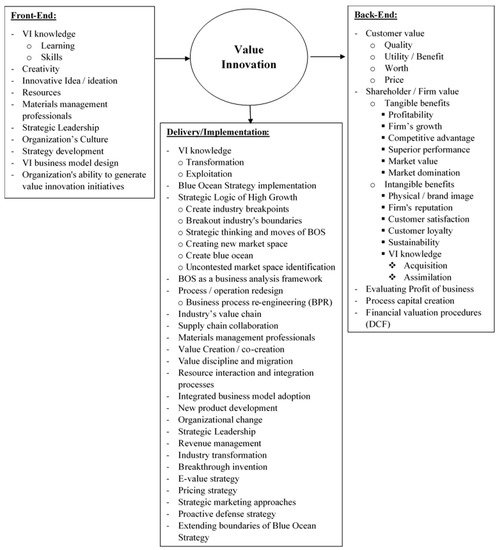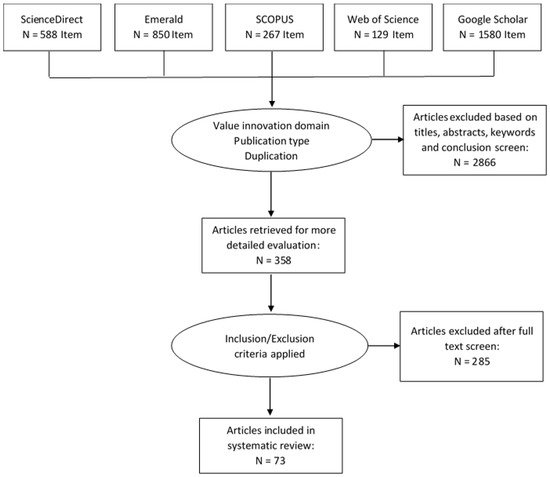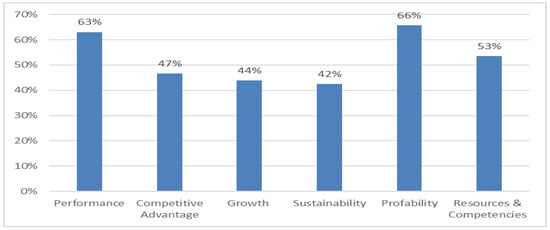
| Version | Summary | Created by | Modification | Content Size | Created at | Operation |
|---|---|---|---|---|---|---|
| 1 | Mohammed A. Al-Sharafi | + 2548 word(s) | 2548 | 2021-09-18 08:14:58 | | | |
| 2 | Dean Liu | -3 word(s) | 2545 | 2021-10-26 05:16:04 | | | | |
| 3 | Dean Liu | -3 word(s) | 2545 | 2021-10-26 05:17:05 | | |
Video Upload Options
Value innovation, as defined by Kim and Mauborgne, and Kim and Mauborgne, is making “the competition irrelevant by offering fundamentally new and superior buyer value in existing markets and by enabling a quantum leap in buyer value to create new markets”. The concept of value innovation is a summation of analytical outcomes from 150 strategic moves spanning more than 30 companies, worldwide, in approximately 30 industries, as well as a study for the business launched of approximately 100 companies to quantify the influence of value innovation on a company’s growth in revenues and profits. From a company perspective, Mohanty, Mele, Mele, Russo Spenaviewed value innovation as resource integration and superior competency development; meanwhile, Setijonodescribed value innovation as “creating stakeholder value through radical (disruptive)-attractive quality”, where the logic behind it is to provide a total solution, extraordinary experiences, and cost reduction through product, service, and delivery platforms.
1. Introduction
As a key of differentiation and strategic logic of high growth, value innovation has received considerable attention from many scholars in the past two decades. The concept of value innovation was first introduced by Kim and Mauborgne in 1997 to avoid head-to-head competition and create new market spaces with irrelevant competition factors instead. Later, Kim and Mauborgne [1] developed the blue ocean strategy (BOS) as an actionable analytic tool and framework for a value innovation business approach. “Blue ocean” denotes the business opportunities of value innovation that focus on developing quantum leaps in value for customers and shareholders and creating an uncontested market that makes the competition irrelevant with the existing fiercely competitive market or “red ocean” [1].
Over the past 20 years, value innovation has been linked with many business approaches in strategic management and marketing planning fields, such as competitive advantage, superior performance, customer value, shareholder value, high profitability, and sustainable growth. Many researchers have also investigated value innovation in various research domains, including value chain, idea creation, business model adaption, process redesign, and implementation techniques. They merged blue ocean’s analytic tools with other research areas, especially strategy canvas and four action framework techniques. Such investigations and merging have resulted in the lack of conceptual clarity, in which some researchers and companies seem to address value innovation for technological breakthroughs [2][3][4][5][6], whereas others focus on organizational innovations and business marketing techniques [7][8][9][10][11][12][13][14]. Despite this divergence in researchers’ perspectives, the optimum goals of adopting value innovation remain almost similar, which is advantageous for long-term survival and success.
Recently, the rapid market transformation associated with unexpected global issues, such as COVID-19, climate change, population ageing, and critical raw materials scarcities, escalates the importance for firms to link their innovation strategies with business performance and sustainability. This gives value innovation a broader perspective of adding sustainability dimension to the mean of value for customers and shareholders. According to Yang and Jang [15], “corporate sustainability will be profitable only when the business model includes a goal of sustainability”. The improvements of a sustainability-oriented form of innovations are beyond technological changes to changes in processes, operation practices, business models, and business systems [16]. Thus, building a new value innovation business model, with the means of sustainability and the intangible resource-integration perspective, has become a necessity for a firm to enhance business performance, competitive advantage, and sustainable growth.
2. Value Innovation Front-End

3. Value Innovation Implementation

3.1. Value Innovation Back-End

References
- Kim, W.C.; Mauborgne, R. Blue Ocean Strategy; Harvard Business Review Paperback Series; Harvard Business School Press: Brighton, UK, 2004; pp. 1–10.
- Buisson, B.; Silberzahn, P. Blue ocean or fast-second innovation? A Four-breakthrough model to explain successful market domination. Int. J. Innov. Manag. 2010, 14, 359–378.
- Koh, J.; Wang, B. Breakthrough markets, innovation and internet firms. Int. J. Bus. Innov. Res. 2012, 6, 322–335.
- El Sawy, O.A.; Malhotra, A.; Gosain, S.; Young, K.M. IT-intensive value innovation in the electronic economy: Insights from Marshall Industries. MIS Q. 1999, 23, 305–335.
- Carli, R.; Del Moro, A.; Righi, C. Properties and Control of Fluxes for Ingot Casting and Continuous Casting. Metall. Ital. 2008, 5, 13–18.
- Liu, D.-Y.; Liu, C.-C. Success with venture capital: A case study on business strategy. Int. J. Inf. Syst. Chang. Manag. 2007, 2, 372–391.
- Ochieng, C.M.O. Revitalising African agriculture through innovative business models and organisational arrangements: Promising developments in the traditional crops sector. J. Mod. Afr. Stud. 2007, 45, 143–169.
- Matthyssens, P.; Vandenbempt, K.; Berghman, L. Value innovation in business markets: Breaking the industry recipe. Ind. Mark. Manag. 2006, 35, 751–761.
- Yang, C.-C.; Yang, K.-J. An integrated model of value creation based on the refined Kano’s model and the blue ocean strategy. Total Qual. Manag. Bus. Excell. 2011, 22, 925–940.
- Yang, J.-t. Effects of ownership change on organizational settings and strategies in a Taiwanese hotel chain. Int. J. Hosp. Manag. 2012, 31, 428–441.
- Setijono, D. Model and principles of stakeholders-oriented quality management based on radical (discontinuous) improvement–a modern re-interpretation of TQM and CWQC? Int. J. Qual. Innov. 2010, 1, 167–183.
- Kachouie, R.; Mavondo, F.; Sands, S. Dynamic marketing capabilities view on creating market change. Eur. J. Mark. 2018, 52, 1007–1036.
- Wollmann, D.; Tortato, U. Proposal for a model to hierarchize strategic decisions according to criteria of value innovation, sustainability and budgetary constraint. J. Clean. Prod. 2019, 231, 278–289.
- Vieira, E.R.M.; Ferreira, J.J. Strategic framework of fitness clubs based on quality dimensions: The blue ocean strategy approach. Total Qual. Manag. Bus. Excell. 2018, 29, 1648–1667.
- Yang, S.J.; Jang, S. How Does Corporate Sustainability Increase Financial Performance for Small-and Medium-Sized Fashion Companies: Roles of Organizational Values and Business Model Innovation. Sustainability 2020, 12, 10322.
- Kneipp, J.M.; Gomes, C.M.; Bichueti, R.S.; Frizzo, K.; Perlin, A.P. Sustainable innovation practices and their relationship with the performance of industrial companies. Rev. Gestão 2019, 26, 94–111.
- Kim, C.; Mauborgne, R. Strategy, value innovation, and the knowledge economy. MIT Sloan Manag. Rev. 1999, 40, 41.
- Mele, C. Value innovation in B2B: Learning, creativity, and the provision of solutions within Service-Dominant Logic. J. Cust. Behav. 2009, 8, 199–220.
- González-Cruz, T.F.; Roig-Tierno, N.; Botella-Carrubí, D. Quality management as a driver of innovation in the service industry. Serv. Bus. 2018, 12, 505–524.
- Tang, S.F.; Tong, P.Y. E-Value Strategies in Internet Retailing: The Case of a Malaysian Leading E-Coupon Retailer. Asian Soc. Sci. 2013, 9, 252.
- Aboujafari, M.R.; Farhadnejad, M.M.; Fakher, H.R.; Bagherzadeh, M. Study of Blue Ocean Strategy Effect on the Market Value of Listed Companies in Tehran Stock Exchange Market. Life Sci. J. 2013, 10, 61–69.
- Dillon, T.A.; Lee, R.K.; Matheson, D. Value innovation: Passport to wealth creation. Res.-Technol. Manag. 2005, 48, 22–36.
- Kulkarni, B.; Sivaraman, V. Making a Blue Ocean Shift: Tata Ace captures a new market. J. Bus. Strategy 2019, 41, 11–20.
- Mele, C.; Russo Spena, T.; Colurcio, M. Co-creating value innovation through resource integration. Int. J. Qual. Serv. Sci. 2010, 2, 60–78.
- Liao, S.-H.; Kuo, F.-I. The study of relationships between the collaboration for supply chain, supply chain capabilities and firm performance: A case of the Taiwan’s TFT-LCD industry. Int. J. Prod. Econ. 2014, 156, 295–304.
- Dikmen, I.; Birgonul, M.T.; Artuk, S.U. Integrated framework to investigate value innovations. J. Manag. Eng. 2005, 21, 81–90.
- Berghman, L.; Matthyssens, P.; Vandenbempt, K. Value innovation, deliberate learning mechanisms and information from supply chain partners. Ind. Mark. Manag. 2012, 41, 27–39.
- Ho, Y.-C.; Tsai, C.-T. Comparing ANFIS and SEM in linear and nonlinear forecasting of new product development performance. Expert Syst. Appl. 2011, 38, 6498–6507.
- Liao, S.-H.; Hu, D.-C.; Ding, L.-W. Assessing the influence of supply chain collaboration value innovation, supply chain capability and competitive advantage in Taiwan’s networking communication industry. Int. J. Prod. Econ. 2017, 191, 143–153.
- Xi, Y.; Zhang, X.; Liu, Y.; Wei, J. Business modeling for entrepreneurial firms: Four cases in China. Chin. Manag. Stud. 2013, 7, 344–359.
- Hajar, M.A.; Ibrahim, D.N.; Darun, M.R.; Al-Sharafi, M.A. The Role of Emerging Technologies in Shaping the Value Innovation Aptitude Towards Competitive Advantage and Sustainability. In Proceedings of the Information and Communication Technologies in Organizations and Society, Paris, France, 5–6 November 2020.
- Mohanty, R. Value innovation perspective in Indian organizations. Particip. Empower. Int. J. 1999, 7, 88–103.
- Lindgreen, A.; Hingley, M.; Matthyssens, P.; Vandenbempt, K.; Berghman, L. Value innovation in the functional foods industry: Deviations from the industry recipe. Br. Food J. 2008, 110, 144–155.
- Kim, C.; Mauborgne, R. Blue Ocean Strategy: How to Create Uncontested Market Space and Make Competition Irrelevant; Harvard Business School Press: Brighton, UK, 2005.
- Agnihotri, A. Extending boundaries of Blue Ocean Strategy. J. Strateg. Mark. 2016, 24, 519–528.
- Chang, S.-C. Bandit cellphones: A blue ocean strategy. Technol. Soc. 2010, 32, 219–223.
- Kim, C.; Mauborgne, R. Value innovation: The strategic logic of high growth. Harv. Bus. Rev. 1997, 82, 172–180.
- Xavier, J.A.; Siddiquee, N.A.; Mohamed, M.Z. Public management reform in the post-NPM era: Lessons from Malaysia’s National Blue Ocean Strategy (NBOS). Public Money Manag. 2019, 41, 152–160.
- Pateman, J. Blue Ocean Strategy: Making a Blue Ocean Shift at Thunder Bay Public Library. Public Libr. Q. 2019, 38, 353–368.
- Christodoulou, I.; Langley, P.A. A gaming simulation approach to understanding blue ocean strategy development as a transition from traditional competitive strategy. J. Strateg. Mark. 2019, 28, 727–752.
- Parvinen, P.; Aspara, J.; Hietanen, J.; Kajalo, S. Awareness, action and context-specificity of blue ocean practices in sales management. Manag. Decis. 2011, 49, 1218–1234.
- Lindič, J.; Bavdaž, M.; Kovačič, H. Higher growth through the Blue Ocean Strategy: Implications for economic policy. Res. Policy 2012, 41, 928–938.
- Jacobs, H.; Zulu, C. Reaping the benefits of value innovation: Lessons for small agribusinesses in Africa. Afr. J. Bus. Manag. 2012, 6, 9510–9523.
- Kim, C.; Yang, K.H.; Kim, J. A strategy for third-party logistics systems: A case analysis using the blue ocean strategy. Omega 2008, 36, 522–534.
- Mina, F.T.; Mohseni, R. Blue ocean strategy (evaluating profit of businesses in the industrial town of bu ali in hamadan). Int. J. Appl. Bus. Econ. Res. 2015, 13, 1941–1952.
- Hollensen, S. The Blue Ocean that disappeared–the case of Nintendo Wii. J. Bus. Strategy 2013, 34, 25–35.
- Wubben, E.F.; Düsseldorf, S.; Batterink, M.H. Finding uncontested markets for European fruit and vegetables through applying the Blue Ocean Strategy. Br. Food J. 2012, 114, 248–271.
- Tarantino, D.P.; Smith, D.B. Bariatric surgery: Assessing opportunities for value innovation. Surg. Innov. 2005, 12, 91–99.
- Vieira, E.; Ferreira, J.J.; São João, R. Creation of value for business from the importance-performance analysis: The case of health clubs. Meas. Bus. Excell. 2019, 23, 199–215.
- Coughlan, P.; Fergus, M.A. Defining the path to value innovation. Int. J. Manuf. Technol. Manag. 2009, 16, 234–249.
- Wee, C.H. Think tank—Beyond the five forces model and blue ocean strategy: An integrative perspective from Sun Zi Bingfa. Glob. Bus. Organ. Excell. 2017, 36, 34–45.
- Kim, C.; Mauborgne, R. Creating new market space. Harv. Bus. Rev. 1999, 77, 83–93.
- Kim, R.B. Value innovation in export marketing strategy: The case of a Canadian firm in Japan. J. Food Prod. Mark. 2010, 16, 361–372.
- Lai, Y.; Khoong, C.; Aw, T. Value innovation through business process re-engineering: A&E services at a public hospital. Knowl. Process Manag. 1999, 6, 139.
- Mohanty, R.; Deshmukh, S. Reengineering of materials management system: A case study. Int. J. Prod. Econ. 2001, 70, 267–278.
- Mohanty, R.; Deshmukh, S. Business process reengineering: Value innovation in industrial engineering practices. Int. J. Comput. Appl. Technol. 2001, 14, 119–135.
- Hajar, M.A.; Ibrahim, D.N.; Darun, M.R.; Al-Sharafi, M.A. Value Innovation Activities in Wireless Telecommunications Service Sector: A Case Study on Malaysian Market Service Sector: A Case Study on Malaysian Market. J. Glob. Bus. Insights 2020, 5, 57–72.
- Sitinjak, M.F.; Pramawijaya, K.; Gunawan, A. ICanStudioLive use of Blue Ocean Marketing Strategy for Value Differentiation. Pertanika J. Soc. Sci. Humanit. 2018, 26, 203–214.
- Rabino, S.; Gabay, G.; Moskowitz, D.; Moskowitz, H.R. Assessing pricing for a new product concept: PDA+ electronic health records+ real-time monitoring. J. Direct Data Digit. Mark. Pract. 2010, 12, 27–51.
- Ernst, H.; Kahle, H.N.; Dubiel, A.; Prabhu, J.; Subramaniam, M. The antecedents and consequences of affordable value innovations for emerging markets. J. Prod. Innov. Manag. 2015, 32, 65–79.
- Yang, J.-t. Identifying the attributes of blue ocean strategies in hospitality. Int. J. Contemp. Hosp. Manag. 2012, 24, 701–720.
- Loosemore, M.; Richard, J. Valuing innovation in construction and infrastructure: Getting clients past a lowest price mentality. Eng. Constr. Archit. Manag. 2015, 22, 38–53.
- Donada, C. Electric mobility calls for new strategic tools and paradigm for automakers. Int. J. Automot. Technol. Manag. 2013, 13, 167–182.
- Tseng, M.-L.; Lim, M.K.; Wu, K.-J. Improving the benefits and costs on sustainable supply chain finance under uncertainty. Int. J. Prod. Econ. 2019, 218, 308–321.
- Kim, C.; Mauborgne, R. Value innovation: A leap into the blue ocean. J. Bus. Strategy 2005, 26, 22–28.
- Hajar, M.A.; Ibrahim, D.N.; Darun, M.R. Value Innovation: The New Source Of Sustainability. In Proceedings of the Advances in Global Business Research, New Delhi, India, 2–4 July 2019; pp. 1029–1037.
- Carter, T.; Diro Ejara, D. Value innovation management and discounted cash flow. Manag. Decis. 2008, 46, 58–76.
- Shafiq, M.; Tasmin, R.; Takala, J.; Qureshi, M.I.; Rashid, M. Mediating role of open innovation between the relationship of Blue ocean strategy and innovation performance, a study of Malaysian industry. Int. J. Eng. Technol. 2018, 7, 1076–1081.
- Yap, J.B.H.; Chua, K.L. Application of e-booking system in enhancing Malaysian property developers’ competitive advantage: A blue ocean strategy? Prop. Manag. 2018, 36, 86–102.
- Shafiq, M.; Tasmin, R.; Qureshi, M.I.; Takala, J. A new framework of blue ocean strategy for innovation performance in manufacturing sector. Int. J. Eng. Adv. Technol. 2019, 8, 1382–1389.
- Hsiao, H.-C.; Chang, J.-C.; Yeh, Y.-M.; Chen, S.-C.; Chou, C.-M.; Shen, C.-H. Creation of customer value innovation with refined service: Taking ABC life logistics company in Taiwan as an example. In Proceedings of the Logistics Systems and Intelligent Management, Harbin, China, 9–10 January 2010; pp. 803–808.




